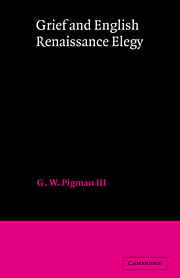Book contents
- Frontmatter
- Contents
- Acknowledgments
- Introduction
- Chapter 1 The Angry Consoler
- Chapter 2 The Emergence of Compassionate Moderation
- Chapter 3 Praise and Mourning
- Chapter 4 The Shift from Anxious Elegy
- Chapter 5 Surrey and Spenser
- Chapter 6 Jonson and King
- Chapter 7 Milton
- Conclusion
- Notes
- Bibliography
- Index
Chapter 5 - Surrey and Spenser
Published online by Cambridge University Press: 28 August 2009
- Frontmatter
- Contents
- Acknowledgments
- Introduction
- Chapter 1 The Angry Consoler
- Chapter 2 The Emergence of Compassionate Moderation
- Chapter 3 Praise and Mourning
- Chapter 4 The Shift from Anxious Elegy
- Chapter 5 Surrey and Spenser
- Chapter 6 Jonson and King
- Chapter 7 Milton
- Conclusion
- Notes
- Bibliography
- Index
Summary
Surrey
Surrey writes with greater ease when he is restraining or hinting at his grief or attacking the enemies of the deceased. Some of his efforts to lament are peculiarly awkward, and his most moving elegy is a poem which disguises the fact that it is an elegy. Suppressed grief is the dominant note instead of anxious reflection on the legitimacy of mourning, even though one of the elegies is a justification of grief for Wyatt.
Some time before 8 August 1537, in the grounds of Windsor, Surrey struck Edward Seymour, presumably for spreading the rumor that Surrey and his father, the Duke of Norfolk, were in sympathy with the Pilgrimage of Grace. Violence within the court was considered a personal threat to the king, and an offender ran the risk of losing his right hand, his goods, his lands, and of imprisonment at the king's pleasure. Norfolk was worried that his son would lose his hand, but Surrey was only confined to the grounds of Windsor. ‘So crewell prison’ is a product of that confinement, perhaps a protest against it. One of Surrey's motives for writing the poem may have been to call attention to his special friendship with his brother-in-law, Henry VIII's illegimate son, Henry Fitzroy, Duke of Richmond, in an effort to persuade the king to release him from Windsor.
- Type
- Chapter
- Information
- Grief and English Renaissance Elegy , pp. 68 - 84Publisher: Cambridge University PressPrint publication year: 1985



